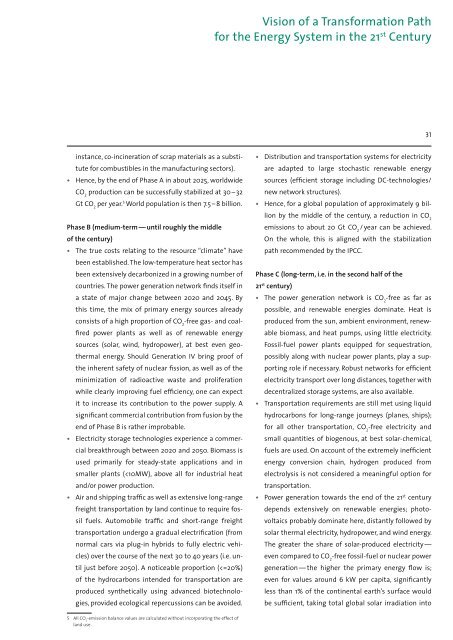Energy Strategy for ETH Zurich
Energy Strategy for ETH Zurich
Energy Strategy for ETH Zurich
Create successful ePaper yourself
Turn your PDF publications into a flip-book with our unique Google optimized e-Paper software.
•<br />
instance, co-incineration of scrap materials as a substitute<br />
<strong>for</strong> combustibles in the manufacturing sectors).<br />
Hence, by the end of Phase A in about 2025, worldwide<br />
CO 2 production can be successfully stabilized at 30 – 32<br />
Gt CO 2 per year. 5 World population is then 7.5 – 8 billion.<br />
Phase B (medium-term — until roughly the middle<br />
of the century)<br />
•<br />
•<br />
•<br />
The true costs relating to the resource “climate” have<br />
been established. The low-temperature heat sector has<br />
been extensively decarbonized in a growing number of<br />
countries. The power generation network finds itself in<br />
a state of major change between 2020 and 2045. By<br />
this time, the mix of primary energy sources already<br />
consists of a high proportion of CO -free gas- and coal-<br />
2<br />
fired power plants as well as of renewable energy<br />
sources (solar, wind, hydropower), at best even geothermal<br />
energy. Should Generation IV bring proof of<br />
the inherent safety of nuclear fission, as well as of the<br />
minimization of radioactive waste and proliferation<br />
while clearly improving fuel efficiency, one can expect<br />
it to increase its contribution to the power supply. A<br />
significant commercial contribution from fusion by the<br />
end of Phase B is rather improbable.<br />
Electricity storage technologies experience a commercial<br />
breakthrough between 2020 and 2050. Biomass is<br />
used primarily <strong>for</strong> steady-state applications and in<br />
smaller plants (
















